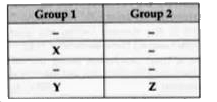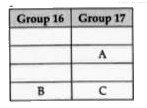The position of three elements X, Y and Z in the periodic table are shown below:
(i) Which type of ion, cation or anion, will be formed by element X ?
(ii) Which element, Y or z, has the atom of comparatively larger size ?
Give reason in each case.
 Solution in Kannada
Solution in Kannada
(i) The valency of X is one. It has tendency to lose one electron. Therefore, X will form cation.
(ii) Y, because atomic radius decreases across a period due to increase in the electrostatic force between electrons and nucleus.
Topper's Solved these Questions
- BOOK - OSWAAL PUBLICATIONCHAPTER - PERIODIC CLASSIFICATION OF ELEMENTSEXERCISE - TOPIC:2- SHORT ANSWER TYPE QUESTIONS-II45videos
PERIODIC CLASSIFICATION OF ELEMENTS
- BOOK - OSWAAL PUBLICATIONCHAPTER - PERIODIC CLASSIFICATION OF ELEMENTSEXERCISE - TOPIC:2- LONG ANSWER TYPE QUESTIONS5videos
PERIODIC CLASSIFICATION OF ELEMENTS
- BOOK - OSWAAL PUBLICATIONCHAPTER - PERIODIC CLASSIFICATION OF ELEMENTSEXERCISE - TOPIC:2- VERY SHORT ANSWER TYPE QUESTIONS18videos
PERIODIC CLASSIFICATION OF ELEMENTS
- BOOK - OSWAAL PUBLICATIONCHAPTER - METALS AND NON-METALSEXERCISE - NCERT CORNER (Textbook Exercises)16videos
METALS AND NON-METALS
- BOOK - OSWAAL PUBLICATIONCHAPTER - SOLVED PAPER SSLC KARNATAKA APRIL 2019 EXERCISE - QUESTIONS49videos
SOLVED PAPER SSLC KARNATAKA APRIL 2019
Similar Questions
The atomic numbers of two elements A and B are 11 and 12 respectively. Which element exhibits highest metallic property ? Why ? Write the molecular formula of the compounds formed when these elements combine with the element 'Z' having atomic number 8.
04:54View SolutionExamine the elements of the third period and classify them as metals or non-metals. Comment on the metallic and non-metallic character of the third period. Name the most metallic element and non-metallic element of this period.
08:52View SolutionAn element has atomic number 3. To which period of the periodic table does it belong?
04:52View SolutionWhich of the following is double displacement reaction ?
03:40View SolutionThe change that occurs in the eye to see the distant object clearly is
04:10View SolutionThe atomic numbers of the three elements X,Y and Z are 2,6 and 10 respectively
(i) Which two elements belong to the same group?
(ii) Which two elements belong to the same period?
Given reasons for your choice.03:01View SolutionThe position of three elements A, B and C in che periodic table are shown below : (a) State whether A is metal or non-metal. (b) Seate whether C is more reactive or less reactive than A. (c) Will C be larger or smaller in size than B ? (d) Which type of ion, cation or anion will be formed by the element A ?
04:52View SolutionThe position of three elements A, B and C in the periodic Table is shown below:

(a) State whether A is a metal or non-metal
(b) State whether C is more reactive or less reactive than A
( c) Will C be larger or smaller in size than B?
(d) Which type of ion, cation or anion, will be formed by element C?View SolutionThe position of three elements A, B and C in the Periodic Table are shown below: (a) State whether A is a metal or a non-metal. (b) State whether C is more reactive or less reactive than A. (c) Will C be larger or smaller in size than B? (d) Which type of ion-cation or anion will be formed by element A?
02:49View SolutionThe position of three elements A, B and C in the Periodic Table is shown below:

Giving reasons, explain the following:
(i) Element A is a metal.
(ii) Element C has larger size than element B.
(iii) Element B has a valency of 3.01:32View SolutionThree elements X, Y and Z have atomic numbers 7, 10 and 14 respectively.
(i) Identify the group number of these elements in the periodic table.
(ii) Mention one unique feature each of elements Y and Z.
(iii) Which of the above two elements belong to the same period ?01:17View SolutionThe position of three elements A, B and C in the periodic Table is shown below: (a) State whether A is a metal or non-metal (b) State whether C is more reactive or less reactive than A ( c) Will C be larger or smaller in size than B? (d) Which type of ion, cation or anion, will be formed by element C?
04:58View SolutionThere are three elements X, Y and Z having atomic numbers of 6, 16 and 19 respectively. Based on this information, Het has been asked to answer the following questions:
In which group of the periodic table would you expect to find (i) element x (ii) element Y and (iii) element z?01:32View SolutionThe position of three elements A, B and C in the periodic table are as shown below: Which type ion, cation or anion, will be formed by elements A ?
02:14View SolutionElements W, X, Y, Z in the periodic table are shown below: State whether W is smaller or larger than Z in size
03:40View Solution

